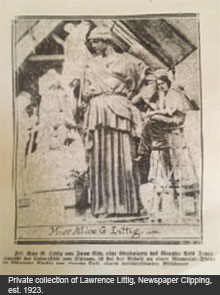
Abstract: This St. Mary’s Project has two primary purposes: the first is to reconstruct the career of the artist Alice Littig Siems through historical evidence while providing context for understanding the time and place in which she operated, and the second is to analyze what systematic, historical, and art historical factors contributed to her status as a largely unknown artist. This investigation is based in feminist theory, seeking to clarify how the artist’s gender affected her career and her place in history. The idea behind this project is partially driven by the question posed by the art historian Linda Nochlin: ‘why have there been no great women artists?’ Alice Littig Siems is unknown today because of the type of work she produced (neoclassical busts), and because of her status as a female artist. The work that Alice Littig Siems created is what would have been both profitable and possible for a woman artist in her time, therefore her status as a forgotten artist is related to systematic gender roles. Both scholarly and extensive archival sources provided the evidence used to reconstruct this timeline of her career and assess its significance. A group of female sculptors nicknamed the White Rabbits, who apprenticed under the same teacher as Littig Siems, provide context for the status of women in the field of sculpture in the midwest at the turn of the twentieth century.